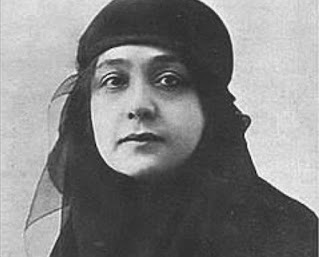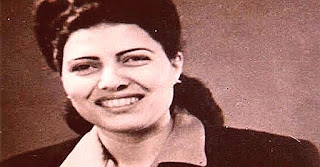With steady and strong steps. They changed the reality for the better and influenced their societies to have a history of achievements that is calculated in the balance of Arab women.
Through activities and activities that celebrate women and their efforts in social, cultural and political life.
- Princess Fatima Ismail
She took care of culture and science but was unable to enter the university to prevent girls at this time from attending university, but the dream came true another way when Princess Fatima Ismail decided to donate a plot of land to build Egypt's first university.
Egypt's renaissance in the first half of the 20th century dates back to the founding of its first university.
The story goes back when the Egyptians tried to establish a university, at first a public subscription was made to collect donations from the Egyptian people, starting with the rich and the coming and ending with schoolchildren, along with some support from The Khadawi Egypt Abbas II, and indeed a temporary building was rented and when they were unable to pay its rent was replaced by another building as a temporary headquarters of the university, and the project continued to suffer financial difficulties for more than ten years .
Princess Fatima Ismail decided to donate a large plot of land she owned in Giza to build a permanent university headquarters on it, and also donated most of her jewelry to spend on university construction, and in order for Princess Fatima to ensure the sustainability of the project, she stopped 600 acres of her folds to cover his annual expenses.
Today, more than 100 years after its inception, Cairo University is Egypt's largest and oldest university.
Princess Fatima Ismail was born in June 1853 and was unique in her general love for good and her contribution to charity. among her sisters.
- Zoha Hadid
Unique in a range of exotic and
distinctive architectural constructions around the world, Iraqi architect Zaha Hadid designed many buildings in Europe, Asia and America, leaving a number of architectural projects still under way, such as the Abu Dhabi Bridge in the UAE and the Fire Station in Germany.
She won numerous prestigious awards, medals and honorary titles in architecture, was one of the first women to receive the Pritzker Prize in Architecture in 2004, equalling the Nobel Prize in Engineering, the Stirling Prize on two occasions; she won the British Empire Medal and the Japanese Imperial Medal in 2012, and won the Royal Gold Medal at the Riba Engineering Arts Award in 2016, becoming her first woman.
Described as the world's most powerful engineer, she saw architecture not only as the exclusive domain of men, achieving Arab and international achievements, not only architectural designs but also furniture and shoes, and was selected as the fourth most powerful woman in the world in 2010.
It was also characterized by durability, as it used iron in its designs.
Highlights include the 1993 German fire station, the Italian Art Museum building in Rome in 2009, the American in Cincinnati, the Abu Dhabi Bridge and the London Marine Sports Centre, which has been specialized.
Described as the world's most powerful engineer, she saw architecture not only as the exclusive domain of men, achieving Arab and international achievements, not only architectural designs but also furniture and shoes, and was selected as the fourth most powerful woman in the world in 2010.
It was also characterized by durability, as it used iron in its designs.
Highlights include the 1993 German fire station, the Italian Art Museum building in Rome in 2009, the American in Cincinnati, the Abu Dhabi Bridge and the London Marine Sports Centre, which has been specialized.For the 2012 Olympic Games, the Strasbourg subway station, the Cultural Centre of Azerbaijan, the Scientific Centre in Wolsburg, the Steamer Station in Salrino, an ice skating centre in Innsbruck and the Haidar Aliyev Cultural Centre in Baku in 2013 are among the most prominent projects that have brought Hadid well to the world stage.
- Ghada al, Mutairi
Saudi Professor Ghada al-Mutairi has won the highest award for scientific research in America, selecting her research from 10,000 scientific researches to win the $3 million Scientific Creativity Award from America's largest scientific research support organization.
Ghada al-Mutairi is a Saudi professor based in the United States of America who has been with her name for several years.
Ghada had discovered "photon", a metal that allows light to enter the body and reach cells without having to open the body and damage it, the technique "photon" serves as an alternative to surgical procedures in the treatment of many diseases including some cancerous tumors, as well as this technique can be used to treat the heart muscle and detect what may occur defects in that muscle before reaching the occurrence of clots.
Ghada al-Mutairi currently heads a research center at the University of California, San Diego, which uses
nanotechnology in medical treatment.
- Fatima Al , Fahria
The University of Villagers in Fez, Morocco, is the oldest existing university in the world, and it has been graded from being a mosque to becoming an important headquarters for science, where many scholars, most notably Ibn Khaldun and Mohamed Idris, have studied.
Fatima al-Fahria, alias Mother of the Boys, laid the foundation stone for the University of Villagers when she decided to build the Villagers Mosque out of her own money in 859 to contribute to the establishment of one of the most important educational institutions in
history.
 |
| Fatima Al , Fahria |
She fought French colonialism in Algeria until she became the number one French demand and was nicknamed the "Living Martyr", where 20-year-old Jamila Beuhard joined the Algerian National Liberation Front (FLN) at the outbreak of algeria's anti-colonial revolution in 1954.
She was the first volunteer to plant bombs at French gathering places in Algeria.
In 1957, she was arrested after being shot in the shoulder, and in 1958 she was sentenced to death and transferred to Barbados prison, one of the most famous torture institutions of modern times.
When the Commission on Human Rights received millions of letters of disapproval around the world, the execution was postponed and then commuted to life imprisonment.
After algeria's declaration of independence in 1962, she was released and then headed by the Algerian
Women's Union.
- Huda Sharawi
Huda was born in Minya province in 1879, the daughter of Mohammed Sultan Pasha, received education in her family's house, and married early at the age of 13 from her cousin "Ali Al-Sharawi" who is nearly forty years older, and changed her surname after marrying Huda Sultan to Huda "Sharawi" tradition of the West, and one of the conditions of her marriage contract was that her husband divorces his first wife and does not marry her.
She was one of the most prominent figures who embraced women's issues and women's emancipation, and sought to try for women's rights, the removal of the hijab, women's work and equality with men.
From the beginning of the century to the early 1920s, this period marked a critical stage in the history of feminism in Egypt, which saw the beginning of the first sparks of feminist awareness among women such as Huda Sharawi and others, and the beginning of organized
feminism.
 |
| Huda Sharawi |
- Samira Moussa
Samira Moussa is the first Egyptian atomic scientist and the first female dean at Fouad I University's Faculty of Science, currently Cairo University.
Samira Moussa chose the Faculty of Science at Cairo University even though her total qualified her to enter the Faculty of Engineering, when the wish of any girl at the time was to attend the Faculty of Arts, and there drew the attention of her professor Dr. Ali Mustafa Musharraf, the first Egyptian to be dean of the Faculty of Science. I was directly affected by him, not only scientifically but also by the social aspects of his personality.
She received her master's degree in thermal gas communication.
She travelled on a mission to Britain where she studied nuclear radiation, obtaining a Doctorate in X-rays and their impact on various materials.
Moses was killed in 1952 after she responded to an invitation to travel to the United States, where she had the opportunity to conduct research at St. Louis University laboratories.
Observers believe that the evidence indicates that Mossad planned to assassinate her because of her attempt to transfer the nuclear flag to the Arab world, as she intended to set up her own laboratory in Egypt.
Days before she returned to Egypt when she was on her way to visit nuclear plants on the outskirts of California after receiving an invitation to visit the factories, a transport car suddenly appeared to crash into her car and throw it into a deep ravine, and then the transport car disappeared with its driver to prove later that its driver had a pseudonym, but no one was accused of murdering her and the case against an unknown person was tied up.
- Nawal al, Mutawakkil
Nawal al-Mutawakel comes from a Moroccan family of interest in sports, which encouraged her to join Casablanca's Casablanca Municipal Club at the age of 15.
It was her country's first representation of the Moroccan runner at the Mediterranean Games, where Nawal won the gold medal, announcing the start of her successful career. In 1984, she won the gold medal in the 400m hurdles at the Olympics to become the world's first Arab Olympic champion.
Her championship was her future superiority, with Nawal holding many important positions in sports, most notably as first vice president of the Olympic Committee, where she was elected in 2012. In addition, Nawal was appointed Minister of Sports of Morocco in 2007, serving as the first woman to hold this position in the Arab world.


